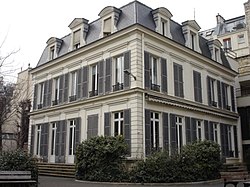The École alsacienne is a co-educational private school located in the 6th arrondissement of Paris.[2][3][4]
| École alsacienne | |
|---|---|
 | |
| Location | |
 | |
109, rue Notre-Dame-des-Champs, Paris | |
| Coordinates | 48°50′28″N 2°20′02″E / 48.841111°N 2.333889°E / 48.841111; 2.333889 |
| Information | |
| Type | Private school |
| Motto | Ad nova tendere sueta (Towards novelty from tradition)[1] |
| Established | 1874 |
| Principal | Pierre de Panafieu |
| Website | https://www.ecole-alsacienne.org/ |
The school was founded by a group of French Alsatians after the French defeat in the Franco-Prussian War. It then became a model for reforming the school system under the Third Republic,[5] and is still to this day a leading establishment of the French secondary education system.
The school was officially founded in 1874,[5] after three years of functioning, by teachers and Protestant academics from Alsace[6] who came to France after the annexation of Alsace-Lorraine by the German Empire during the Franco-Prussian War.
The new school was an establishment for secondary education[6] based on the model of the Jean Sturm Gymnasium, with the ambition of "producing a type of man who was cultivated, and combines the virtues of the regional soul with the general qualities of the humanist".[6] The two first headmasters of the school, Frédéric Rieder (from 1874 to 1891) and Théodore Beck (from 1891 to 1922), were both pastors and former students of the Jean-Sturm Gymnasium.
Later, the school was headed by Henri Péquignat (1922-1936), Jacques Vallette (1936-1945), Jean Neel (1945-1953), Georges Hacquard (1953-1986), Jean-Pierre Hammel (1986-1988), René Fuchs (1988-2001), Pierre de Panafieu (since 2001).
The school rapidly became one of the testing grounds for public education, known as a "pilot school".[5] Non-religious since 1874, mixed in 1908,[7] it insisted from its inception on the importance of French (rather than Latin) and foreign languages. It opened a gymnasium and science labs in 1881. Audiovisual methods of teaching were introduced in 1963, with the introduction of CCTV.
Running from kindergarten to the final year, the École alsacienne is one of the most reputable schools in Paris. Students from the École alsacienne often come from amongst the most privileged sectors of society, due to their selection and admission policies, and its geographic location.[8] However, thanks to its scholarship system and due to the limited price of admission, it has maintained a relative social diversity, with strong attendance from the middle class. The establishment offers relatively few integrated places, as many students stay there throughout their school life.[6] The admissions are mainly made in 6th Form (beginning of middle school), as more than half of the student body is admitted at this time. The school considered opening an establishment in Argenteuil,[6] but the project never took place, due to lack of public investment.[8]
Teaching of sport, plastic arts, and music is central, including in the creation of a classe à horaires aménagés musique in the college.
The school practices education without punishment or reward.[citation needed]
Languages take an important role in the education. German is taught in the first years in the school, but Chinese has been taught since 1963. English courses are obligatory from the beginning of elementary school, and leads to intensive language courses in college and lycée, particularly in the European (specifically English) and Oriental (particularly Chinese) sections.
Since the 2000s, the Ecole alsacienne has offered exchange programs with some partner schools which includes Beijing Jingshan School, Sydney Grammar School, Theresianum Akademie, Daly College, St. Paul's School (New Hampshire), Maru A Pula School, Hotchkiss School, The Dalton School, Lakefield College School, Ashbury College.[9][10]
As the establishment is a private school, education is paid for 912 euros per trimester; there are also scholarships. Entrance is selective: in 2014, there were 300 applications for entry to the 6th Form, for 60 places.[8]
In 2015, the lycée was ranked 12th of 109 at departmental level in terms of teaching quality, and 130th at national level.[11] The ranking was based on three criteria: baccalauréat results, the proportion of students who obtain their baccalauréat having studied at the school for their last two years, and "added value" (calculated based on the social origin of students, their age, and their diploma results).[12] The Ecole alsacienne is ranked 7th in Paris, and 11th nationwide for 2020.[13]
The school is found at 109, rue Notre-Dame-des-Champs in Paris, in the 6th arrondissement of Paris (between the Petit Collège and the Premières/Terminales at 128, rue d’Assas), not far from the Port-Royal and the Jardin du Luxembourg.